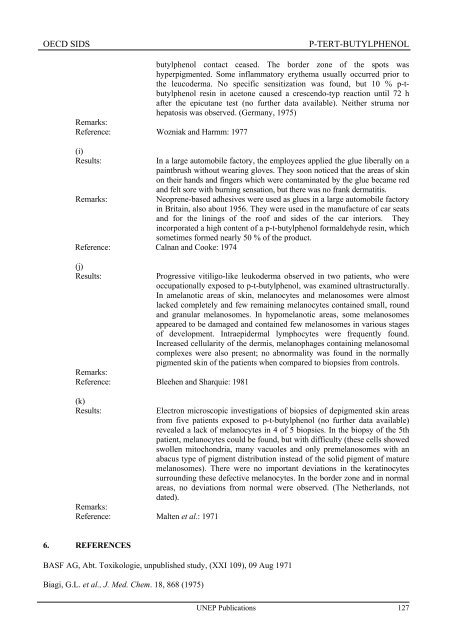p-Tert-Butylphenol - UNEP Chemicals
p-Tert-Butylphenol - UNEP Chemicals
p-Tert-Butylphenol - UNEP Chemicals
Create successful ePaper yourself
Turn your PDF publications into a flip-book with our unique Google optimized e-Paper software.
OECD SIDS P-TERT-BUTYLPHENOL<br />
butylphenol contact ceased. The border zone of the spots was<br />
hyperpigmented. Some inflammatory erythema usually occurred prior to<br />
the leucoderma. No specific sensitization was found, but 10 % p-tbutylphenol<br />
resin in acetone caused a crescendo-typ reaction until 72 h<br />
after the epicutane test (no further data available). Neither struma nor<br />
hepatosis was observed. (Germany, 1975)<br />
Remarks:<br />
Reference: Wozniak and Harmm: 1977<br />
(i)<br />
Results: In a large automobile factory, the employees applied the glue liberally on a<br />
paintbrush without wearing gloves. They soon noticed that the areas of skin<br />
on their hands and fingers which were contaminated by the glue became red<br />
and felt sore with burning sensation, but there was no frank dermatitis.<br />
Remarks: Neoprene-based adhesives were used as glues in a large automobile factory<br />
in Britain, also about 1956. They were used in the manufacture of car seats<br />
and for the linings of the roof and sides of the car interiors. They<br />
incorporated a high content of a p-t-butylphenol formaldehyde resin, which<br />
sometimes formed nearly 50 % of the product.<br />
Reference: Calnan and Cooke: 1974<br />
(j)<br />
Results: Progressive vitiligo-like leukoderma observed in two patients, who were<br />
occupationally exposed to p-t-butylphenol, was examined ultrastructurally.<br />
In amelanotic areas of skin, melanocytes and melanosomes were almost<br />
lacked completely and few remaining melanocytes contained small, round<br />
and granular melanosomes. In hypomelanotic areas, some melanosomes<br />
appeared to be damaged and contained few melanosomes in various stages<br />
of development. Intraepidermal lymphocytes were frequently found.<br />
Increased cellularity of the dermis, melanophages containing melanosomal<br />
complexes were also present; no abnormality was found in the normally<br />
pigmented skin of the patients when compared to biopsies from controls.<br />
Remarks:<br />
Reference: Bleehen and Sharquie: 1981<br />
(k)<br />
Results: Electron microscopic investigations of biopsies of depigmented skin areas<br />
from five patients exposed to p-t-butylphenol (no further data available)<br />
revealed a lack of melanocytes in 4 of 5 biopsies. In the biopsy of the 5th<br />
patient, melanocytes could be found, but with difficulty (these cells showed<br />
swollen mitochondria, many vacuoles and only premelanosomes with an<br />
abacus type of pigment distribution instead of the solid pigment of mature<br />
melanosomes). There were no important deviations in the keratinocytes<br />
surrounding these defective melanocytes. In the border zone and in normal<br />
areas, no deviations from normal were observed. (The Netherlands, not<br />
dated).<br />
Remarks:<br />
Reference: Malten et al.: 1971<br />
6. REFERENCES<br />
BASF AG, Abt. Toxikologie, unpublished study, (XXI 109), 09 Aug 1971<br />
Biagi, G.L. et al., J. Med. Chem. 18, 868 (1975)<br />
<strong>UNEP</strong> Publications 127
















